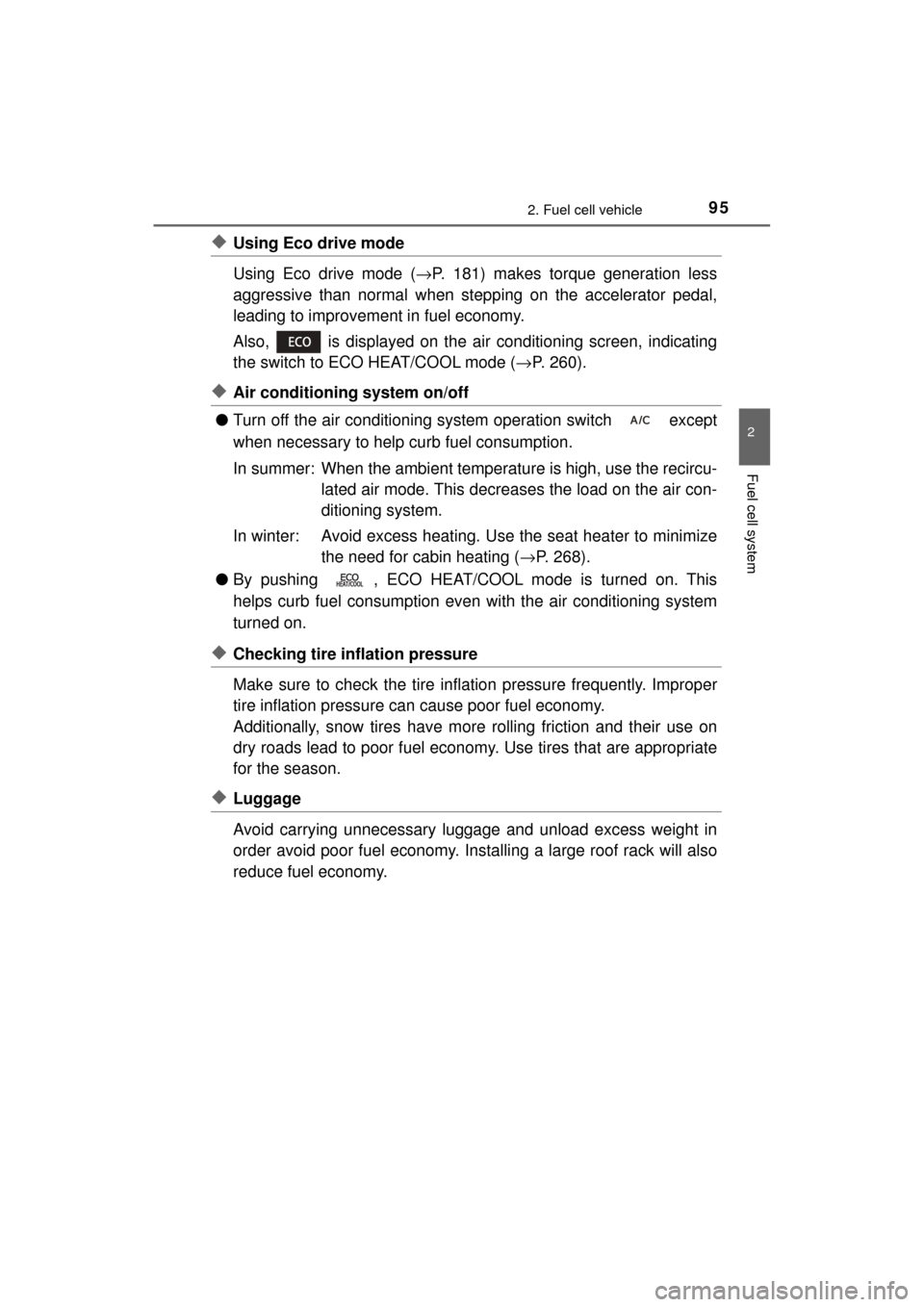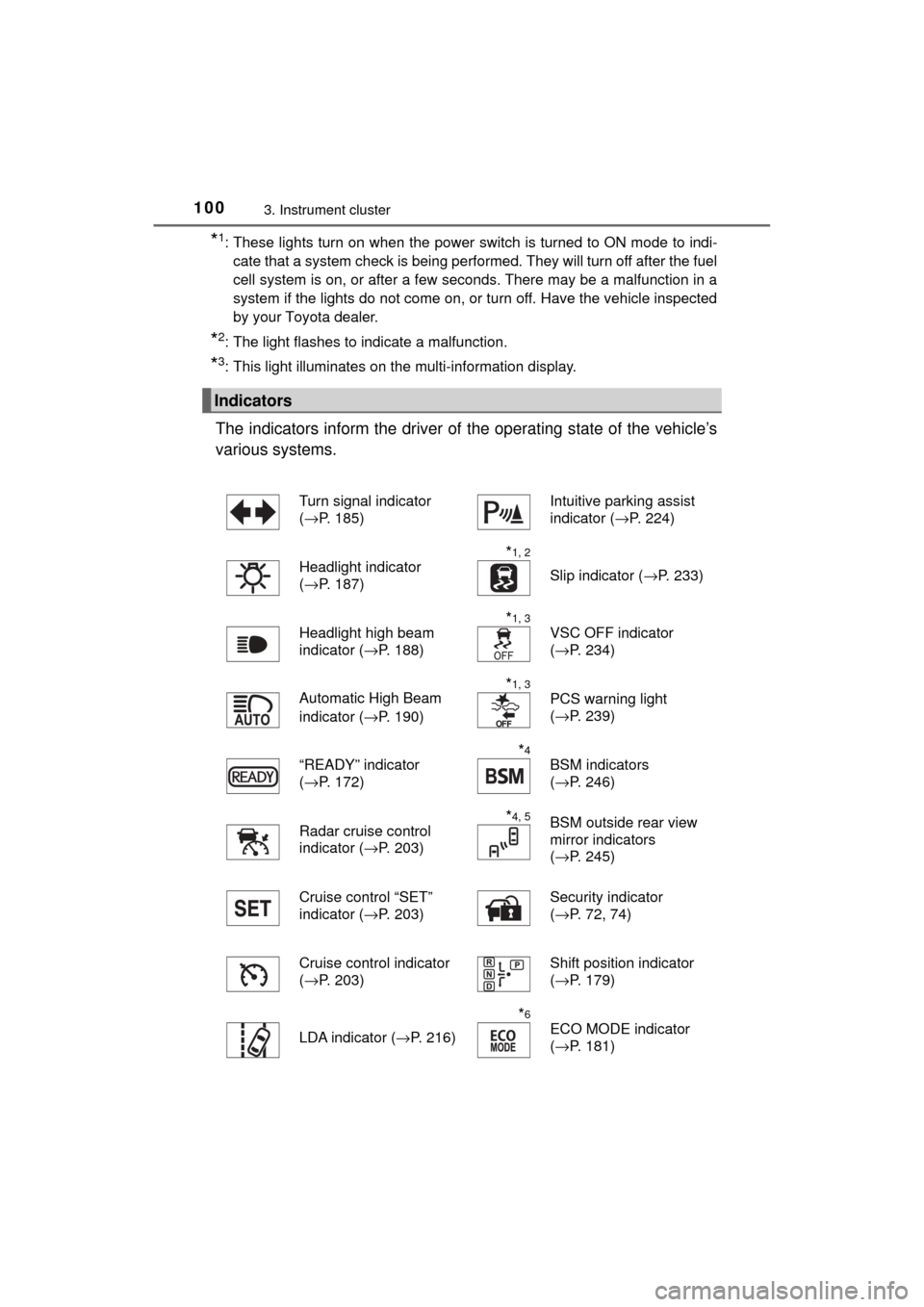Page 90 of 464

902. Fuel cell vehicle
MIRAI_OM_USA_OM62023U■
Basic concepts of hydrogen safety
●Prevent leakage
The pipe joints of the hydrogen pipelines are designed to prevent leaks.
The joints are checked for gas leakage at every official vehicle inspection.
● Detect to stop leakage
• The vehicle is equipped with hydrogen detectors. If the hydrogen detec-
tors detect a leak, the hydrogen tank valves automatically close to pre-
vent more hydrogen from escaping.
• The vehicle is equipped with a collision sensor. If the collision sensor
detects a collision, the hydrogen tank valves automatically close to pre-
vent hydrogen gas from leaking from any damaged components.
● Disperse the leaked hydrogen gas
The hydrogen tanks and pipelines are located outside of the passenger
compartment, so any leaked gas will disperse into the atmosphere by
design.
● Eliminate sources of fire
No source of fire is located near the hydrogen pipelines by design.
WARNING
■Hydrogen-related components
● Never alter, customize, or disassemble any hydrogen-related parts.
● The hydrogen tanks, fuel cell stack, hydrogen pipelines, and connecting
components are filled with hydrogen gas. Do not remove or disassemble
these parts. Doing so can cause a hydrogen gas leak, resulting in fire or
explosion of the vehicle, which may result in death or serious injury.
■ When hydrogen gas leak or other malfunction is detected
● If you notice gas leaking noises or any other malfunction, immediately stop
the vehicle in a safe, well-ventilated place.
● If a warning message is shown on the multi-information display, immedi-
ately stop the vehicle in a safe, well-ventilated place.
● If a large amount of hydrogen gas leaking is noticed, turn off the power
switch, exit the vehicle, and stay far away from it. Display warning signs
and keep sources of fire away from the vehicle. If possible, get assistance.
When the above is done, immediately contact your Toyota dealer.
Page 92 of 464

922. Fuel cell vehicle
MIRAI_OM_USA_OM62023U
WARNING
■Precautions in case of an accident
In the event of an accident, observe the following precautions. Failure to do
so can cause fire or electric shocks, resulting in death or serious injury.
● Stop the vehicle in a safe place to prevent subsequent accidents. Shift the
shift position to P and apply the parking brake.
● Check for hydrogen gas leakage.
Hydrogen leaks will cause a warning message to be shown on the multi-
information display. Larger leaks may also be audible.
● If a large amount of hydrogen gas leaking is noticed, turn off the power
switch, exit the vehicle, and stay far away from it. Display warning signs
and keep sources of fire away from the vehicle. If possible, get assistance.
When the above is done, immediately contact your Toyota dealer.
● Do not touch the high-voltage parts, cables (orange), or connectors.
● If electric wires are exposed inside or outside your vehicle, an electric
shock may occur. Never touch exposed electric wires.
● If a fluid leak occurs, do not touch the fluid as it may be the strong alkaline
electrolyte from the traction battery. If it comes into contact with your skin
or eyes, wash it off immediately with a large amount of water, and seek
immediate medical attention.
● If a vehicle fire occurs, extinguish it with a Class A, B, or C fire extin-
guisher. If using water, apply a large amount from a hydrant.
● In case of a vehicle fire, the hydrogen gas in the hydrogen tanks is
released via the hydrogen tank valves toward the rear of the vehicle
angled downward, in order to reduce the damage to the hydrogen tanks.
Keep away from the vehicle.
● If your vehicle needs to be towed, do so with the front wheels lifted. If the
wheels are touching the ground, the electric motor (traction motor) may
continue to generate electricity. This may cause a fire.
Page 94 of 464

942. Fuel cell vehicle
MIRAI_OM_USA_OM62023U
Advice for driving fuel cell vehicles
◆Fuel cell system indicator usage
Maintaining the fuel cell system indicator to Eco area on the
multi-information display can extend your driving range. (→P. 1 1 0 )
◆Accelerator pedal/brake pedal operation
Drive the vehicle smoothly. Avoid abrupt acceleration and decelera-
tion.
Mild acceleration and deceleration can help curb wasteful fuel con-
sumption.
◆When braking
Make sure to depress the brake gently and allow for a long stopping
distance. This enables collection of more electrical energy gener-
ated during deceleration.
◆Heavy traffic
Repeated acceleration and deceleration as well as long stops at
traffic lights, will decrease fuel economy. Check traffic reports
ahead of time and avoid traffic jams as much as possible. If caught
in a traffic jam, gently release the brake pedal to allow the vehicle to
move forward slowly while avoiding overuse of the accelerator
pedal to help curb wasteful fuel consumption.
◆Driving with high power output
Similar to an electric vehicle, a fuel cell vehicle uses the most fuel in
high output driving such as driv ing on a steep uphill or at high
speeds. Moderate the vehicle speed and maintain a steady speed.
To maximize fuel economy and range, pay attention to the fol-
lowing:
Page 95 of 464

952. Fuel cell vehicle
2
Fuel cell system
MIRAI_OM_USA_OM62023U
◆Using Eco drive mode
Using Eco drive mode (→P. 181) makes torque generation less
aggressive than normal when stepping on the accelerator pedal,
leading to improvement in fuel economy.
Also, is displayed on the air conditioning screen, indicating
the switch to ECO HEAT/COOL mode ( →P. 260).
◆Air conditioning system on/off
● Turn off the air conditioning sy stem operation switch except
when necessary to help curb fuel consumption.
In summer: When the ambient temper ature is high, use the recircu-
lated air mode. This decreas es the load on the air con-
ditioning system.
In winter: Avoid excess heating. Use the seat heater to minimize
the need for cabin heating ( →P. 268).
● By pushing , ECO HEAT/COOL mode is turned on. This
helps curb fuel consumption even with the air conditioning system
turned on.
◆Checking tire inflation pressure
Make sure to check the tire infl ation pressure frequently. Improper
tire inflation pressure can cause poor fuel economy.
Additionally, snow tire s have more rolling friction and their use on
dry roads lead to poor fuel econom y. Use tires that are appropriate
for the season.
◆Luggage
Avoid carrying unnecessary luggage and unload excess weight in
order avoid poor fuel ec onomy. Installing a large roof rack will also
reduce fuel economy.
Page 97 of 464
97
Instrument cluster3
MIRAI_OM_USA_OM62023U3. Instrument cluster
Warning lights and indicators .......................... 98
Gauges and meters .......... 102
Multi-information display ... 107
Page 100 of 464

1003. Instrument cluster
MIRAI_OM_USA_OM62023U
*1: These lights turn on when the power switch is turned to ON mode to indi-cate that a system check is being performed. They will turn off after the fuel
cell system is on, or after a few seconds. There may be a malfunction in a
system if the lights do not come on, or turn off. Have the vehicle inspected
by your Toyota dealer.
*2: The light flashes to indicate a malfunction.
*3: This light illuminates on the multi-information display.
The indicators inform the driver of the operating state of the vehicle’s
various systems.
Indicators
Turn signal indicator
( →P. 185)Intuitive parking assist
indicator ( →P. 224)
Headlight indicator
( →P. 187)
*1, 2
Slip indicator ( →P. 233)
Headlight high beam
indicator ( →P. 188)
*1, 3
VSC OFF indicator
(→P. 234)
Automatic High Beam
indicator ( →P. 190)
*1, 3
PCS warning light
(→P. 239)
“READY” indicator
( →P. 172)
*4
BSM indicators
(→P. 246)
Radar cruise control
indicator ( →P. 203)
*4, 5BSM outside rear view
mirror indicators
(→P. 245)
Cruise control “SET”
indicator ( →P. 203) Security indicator
(
→P. 72, 74)
Cruise control indicator
( →P. 203)
Shift position indicator
(→P. 179)
LDA indicator ( →P. 216)
*6
ECO MODE indicator
(→P. 181)
Page 101 of 464

1013. Instrument cluster
3
Instrument cluster
MIRAI_OM_USA_OM62023U
*1: These lights turn on when the power switch is turned to ON mode to indi-cate that a system check is being performed. They will turn off after the fuel
cell system is on, or after a few seconds. There may be a malfunction in a
system if the lights do not come on, or turn off. Have the vehicle inspected
by your Toyota dealer.
*2: The light flashes to indicate that the system is operating.
*3: The light turns on when the system is off.
*4: In order to confirm operation, the BSM outside rear view mirror indicatorsilluminate in the following situations:
• When the power switch is turned to ON mode while the BSM settings are set to ON.
• When the BSM settings are set to ON while the power switch is in ON mode.
If the system is functioning correctly, the BSM outside rear view mirror indi-
cators will turn off after a few seconds.
If the BSM outside rear view mirror indicators do not illuminate or do not
turn off, there may be a malfunction in the system.
If this occurs, have the vehicle inspected by your Toyota dealer.
*5: This light illuminates on the outside rear view mirrors.
*6: This light illuminates on the main display.
*6
POWER MODE
indicator ( →P. 181)*6
(Amber)
Power restriction
indicator (→P. 102)
Br mode indicator
( →P. 181) H
2O indicator
( →P. 173)
*6
(Blue)
Power restriction
indicator ( →P. 102) “AIR BAG ON/OFF”
indicator (
→P. 49)
WARNING
■If a safety system warning light does not come on
Should a safety system light such as the ABS and SRS warning lights not
come on when you start the fuel cell system, this could mean that these
systems are not available to help protect you in an accident, which could
result in death or serious injury. Have the vehicle inspected by your Toyota
dealer immediately if this occurs.
Page 102 of 464
1023. Instrument cluster
MIRAI_OM_USA_OM62023U
Gauges and meters
Main display
Displays the speedometer, fuel gauge, etc. (→P. 102)
Multi-information display
Presents the driver with a variety of vehicle data.
Displays warning messages in case of a malfunction. ( →P. 376)
Shift position indicator
Displays the selected shift position. (→P. 179)
Clock
→P. 280
Fuel gauge
Displays the quantity of fuel
remaining in the hydrogen
tanks.
Main display